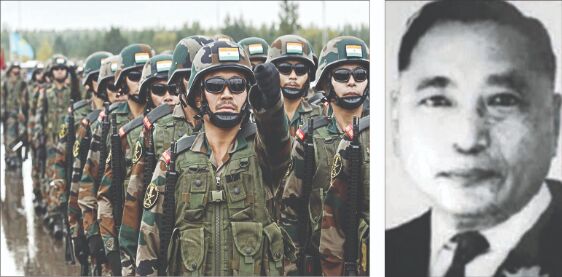Through political settlement
Against SRC’s argument of having united frontiers, demands for autonomy by moderate faction of Nagas culminated into carving out of Nagaland from Assam, also paving the way for statehood of Tripura and Manipur

The Governor of Assam — Sir Akbar Hydari — signed a nine-point agreement with Naga leaders in Kohima in June 1947, wherein the Nagas were provided full autonomy in judicial, legislative and executive matters along with guaranteed non-alienation of their lands. The ninth point read: "The Governor of Assam, as the agent of the Government of the Indian Union, will have a special responsibility for a period of ten years to ensure due observance of this agreement; at the end of the period, the Naga Council will be asked whether they require the above agreement to be extended for a further period, or a new agreement regarding the future
of the Naga people would be arrived at." While Phizo interpreted this to mean the option of Independence after ten years, for the GoI, it meant a choice between remaining a part of Assam, or a separate status within the Union of India.
The Naga autonomous hills district within Assam were given representation in the Lok Sabha and the Assam legislature under Part XVI of the Constitution (articles 330 and 332). However, the Nagas, under the leadership of Phizo, did not participate in the first general elections of 1952, and took up armed insurrection with active connivance from China and East Pakistan. Fed up with the perpetual violence perpetrated by Phizo and his unwillingness to negotiate with the government, the moderate faction of the NNC — led by T Shakhire — decided to hold talks on the issue of autonomy within the Indian Union. Even after he was kidnaped and killed by the extremist faction, the momentum built by him found expression in the Naga Peoples Convention held in August 1957, which authorized Imkongliba Ao to start the negotiations. After discussions with Prime Minister Nehru in September 1957, it was agreed that "the Naga Hills district (of Assam) and the Tuensang frontier division (of NEFA) would be constituted into one unit, to be administered by the Governor of Assam on behalf of the President of India."
Subsequently, two more conventions were held at Mokokchung in 1958 and 1959, when Major Bob Khathing was the Deputy Commissioner, and a decision was taken to press for a state of Nagaland within the Indian Union, as well as the formation of a Naga regiment within the Indian Army, besides the continuation of Inner Line permit. In July 1960, Prime Minister Nehru overruled the recommendations of both the SRC and Home Minister GB Pant, and agreed to the establishment of an interim body of 42 elected members "for the regulation of Nagaland, and matters connected therewith until the creation of Nagaland as a state under the Indian Union. Unfortunately, Imkongliba Ao was also assassinated, but after the initial setback, Shilu Ao, who later became the first Chief Minister, ran the Council for the next two years.
And finally, on December 1, 1963, Nagaland, the 16th state of India with a territory of 6,300 square miles, and a population of approximately 3,70,000, was inaugurated by President S Radhakrishnan at a colourful ceremony in Kohima, with Shilo Ao as the first Chief Minister.
The formation of Nagaland established the principle of supremacy of political settlement over ethnic issues. The SRC's argument of financial and administrative viability was no longer the only determinant. Right from its very inception, it was clear that the state would be heavily dependent on the Union government for funds, as well as functionaries. It also meant that the SRC recommendations with respect to NEFA, Manipur, Tripura, Garo & Jaintia as well as Lushai hill tracts would sooner rather than later be set aside in favour of smaller states and UTs.
As mentioned earlier, much against the wishes of Manipur and Tripura, which had been Chief Commissioner's provinces after their merger with India, the SRC wanted these two to be part of Assam. Even though Manipur and Tripura were quite apart geographically, ethnically, culturally and linguistically, the fates of the two states had been intertwined from 1947 — rulers of both the states had sent CS Guha as their common representative to the Constituent Assembly. Both signed the Instrument of Accession in 1947, and both merged their states to the Indian Union in 1949. Both were initially placed under Chief Commissioners, and narrowly missed integration with Assam in 1956, only to become Union Territories in 1963. Both received statehood in 1972, but this did not mark an end to ethnic insurgencies and extremist ideologies and clashes. Both states also shared a common cadre for the All-India services from 1972 -2014, and there have been no territorial alterations to these states post -1947.
Let us step two centuries back. Tripura accepted the protection of the British in 1809, while Manipur accepted the subsidiary alliance in 1824. Both were salute states, with Tripura's status being a notch higher — it had a 13-gun salute as compared to 11-gun salute of Manipur. It may also be mentioned that during the Raj, the superintendence of Manipur was with the Governor of Assam, while for Tripura it was with the Governor of Bengal. The ruling family and the elite in both the states were heavily influenced by Bengali language, art, culture and religious mores, but to a substantial tribal population, this was a sign of cultural imposition.
Views expressed are personal



